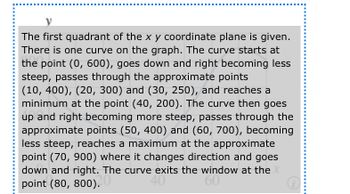
Calculus: Early Transcendentals
8th Edition
ISBN: 9781285741550
Author: James Stewart
Publisher: Cengage Learning
expand_more
expand_more
format_list_bulleted
Question

Transcribed Image Text:The first quadrant of the x y coordinate plane is given.
There is one curve on the graph. The curve starts at
the point (0, 600), goes down and right becoming less
steep, passes through the approximate points
(10, 400), (20, 300) and (30, 250), and reaches a
minimum at the point (40, 200). The curve then goes
up and right becoming more steep, passes through the
approximate points (50, 400) and (60, 700), becoming
less steep, reaches a maximum at the approximate
point (70, 900) where it changes direction and goes
down and right. The curve exits the window at the XX
point (80, 800).20"
40
60
![The graph of a function f is shown.
y
800
400
x
0
20
40
60
(a) Find the average rate of change of f on the interval [50, 60].
(b) Identify an interval on which the average rate of change of f is 0.
○ [10, 50]
[10, 40]
○ [20, 40]
○ [0, 80]
○ [0, 60]
(c) Compute the following.
f(40) - f(0)
40 0
What does this value represent geometrically?
the slope of the tangent line at (20, f(20))
◇ the slope of the line segment from (0, f(0)) to (40, f(40))
O the slope of the tangent line at (40, f(40))
the slope of the tangent line at (0, f(0))
(d) Estimate the value of f' (50).
(e) Is f'(10) > f'(30)?
Yes
No
f(80) - f(40),
(f) Is f'(60) >
80-40
Yes
No
Explain.
The slope of the tangent line at x = 60, f'(60), is less than the slope of the line passing through (40, f(40)) and (80, f(80)).
The slope of the tangent line at x = 40, f'(40), is less than the slope of the line passing through (60, f(60)) and (80, f(80)).
The slope of the tangent line at x = 60, f'(60), is greater than the slope of the line passing through (40, f(40)) and (80, f(80)).
The slope of the tangent line at x = 80, f'(80), is greater than the slope of the line passing through (40, f(40)) and (60, f(60)).
The slope of the tangent line at x = 80, f'(80), is less than the slope of the line passing through (40, f(40)) and (60, f(60)).](https://content.bartleby.com/qna-images/question/af796a3f-89a1-43bc-8a62-1872a1a105f0/9ddb88d7-7b9a-4e79-b6f3-4466d07176c8/i4fhqk_thumbnail.jpeg)
Transcribed Image Text:The graph of a function f is shown.
y
800
400
x
0
20
40
60
(a) Find the average rate of change of f on the interval [50, 60].
(b) Identify an interval on which the average rate of change of f is 0.
○ [10, 50]
[10, 40]
○ [20, 40]
○ [0, 80]
○ [0, 60]
(c) Compute the following.
f(40) - f(0)
40 0
What does this value represent geometrically?
the slope of the tangent line at (20, f(20))
◇ the slope of the line segment from (0, f(0)) to (40, f(40))
O the slope of the tangent line at (40, f(40))
the slope of the tangent line at (0, f(0))
(d) Estimate the value of f' (50).
(e) Is f'(10) > f'(30)?
Yes
No
f(80) - f(40),
(f) Is f'(60) >
80-40
Yes
No
Explain.
The slope of the tangent line at x = 60, f'(60), is less than the slope of the line passing through (40, f(40)) and (80, f(80)).
The slope of the tangent line at x = 40, f'(40), is less than the slope of the line passing through (60, f(60)) and (80, f(80)).
The slope of the tangent line at x = 60, f'(60), is greater than the slope of the line passing through (40, f(40)) and (80, f(80)).
The slope of the tangent line at x = 80, f'(80), is greater than the slope of the line passing through (40, f(40)) and (60, f(60)).
The slope of the tangent line at x = 80, f'(80), is less than the slope of the line passing through (40, f(40)) and (60, f(60)).
Expert Solution
This question has been solved!
Explore an expertly crafted, step-by-step solution for a thorough understanding of key concepts.
Step by stepSolved in 2 steps with 4 images

Knowledge Booster
Similar questions
- At the beginning of COVID- 19 Pandemic, the department of health used a graph to represent the prediction of the number of active cases and the horizontal axis shows the number of days since the start of the pandemic. Pennsylvanians residents were asked to quarantine to flatten the curve of the graph the represented the number of active infections. Which of the following statements are true? Select all the apply.arrow_forwardTo draw a graph for y= 3/4x +7, a person can draw a point at x of 0 and y of _, a second point by going over 3 and up _, and then draw a line through the points.arrow_forwardFind the slope between the points (4/3,4/13) and (19/3,18/13)arrow_forward
arrow_back_ios
arrow_forward_ios
Recommended textbooks for you
 Calculus: Early TranscendentalsCalculusISBN:9781285741550Author:James StewartPublisher:Cengage Learning
Calculus: Early TranscendentalsCalculusISBN:9781285741550Author:James StewartPublisher:Cengage Learning Thomas' Calculus (14th Edition)CalculusISBN:9780134438986Author:Joel R. Hass, Christopher E. Heil, Maurice D. WeirPublisher:PEARSON
Thomas' Calculus (14th Edition)CalculusISBN:9780134438986Author:Joel R. Hass, Christopher E. Heil, Maurice D. WeirPublisher:PEARSON Calculus: Early Transcendentals (3rd Edition)CalculusISBN:9780134763644Author:William L. Briggs, Lyle Cochran, Bernard Gillett, Eric SchulzPublisher:PEARSON
Calculus: Early Transcendentals (3rd Edition)CalculusISBN:9780134763644Author:William L. Briggs, Lyle Cochran, Bernard Gillett, Eric SchulzPublisher:PEARSON Calculus: Early TranscendentalsCalculusISBN:9781319050740Author:Jon Rogawski, Colin Adams, Robert FranzosaPublisher:W. H. Freeman
Calculus: Early TranscendentalsCalculusISBN:9781319050740Author:Jon Rogawski, Colin Adams, Robert FranzosaPublisher:W. H. Freeman
 Calculus: Early Transcendental FunctionsCalculusISBN:9781337552516Author:Ron Larson, Bruce H. EdwardsPublisher:Cengage Learning
Calculus: Early Transcendental FunctionsCalculusISBN:9781337552516Author:Ron Larson, Bruce H. EdwardsPublisher:Cengage Learning

Calculus: Early Transcendentals
Calculus
ISBN:9781285741550
Author:James Stewart
Publisher:Cengage Learning

Thomas' Calculus (14th Edition)
Calculus
ISBN:9780134438986
Author:Joel R. Hass, Christopher E. Heil, Maurice D. Weir
Publisher:PEARSON

Calculus: Early Transcendentals (3rd Edition)
Calculus
ISBN:9780134763644
Author:William L. Briggs, Lyle Cochran, Bernard Gillett, Eric Schulz
Publisher:PEARSON

Calculus: Early Transcendentals
Calculus
ISBN:9781319050740
Author:Jon Rogawski, Colin Adams, Robert Franzosa
Publisher:W. H. Freeman


Calculus: Early Transcendental Functions
Calculus
ISBN:9781337552516
Author:Ron Larson, Bruce H. Edwards
Publisher:Cengage Learning